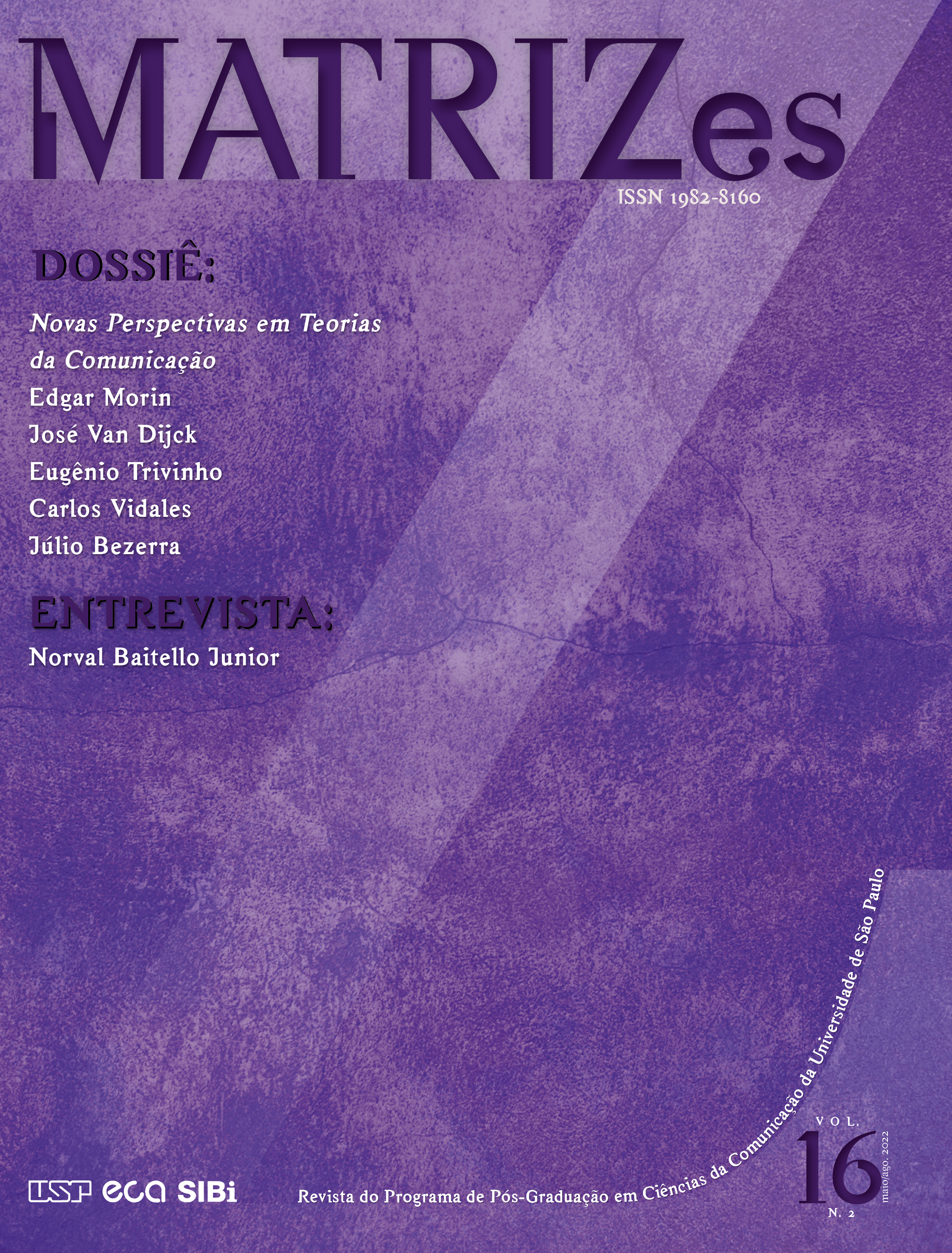Building Communication Theory from Cybersemiotics
DOI:
https://doi.org/10.11606/issn.1982-8160.v16i2p69-98Keywords:
Communication, Theory, Cybersemiotics, Metamodel, Cybernetics, MeaningAbstract
Communication sciences have had a significant problem defining what communication is, what communication is about, and what it describes in biological, human, and mechanical contexts. The mechanistic view sees communication as a process of information exchange while the humanistic view conceptualizes it as meaning production, however, none of them has functioned as common ground for theoretical construction or as a way to identify what is or what is not a communication phenomenon. My answer to this problem is the consideration of communication as a transdisciplinary concept and in doing this I will address two theoretical proposals: Robert T. Craig’s metamodel of communication theory and Søren Brier’s cybersemiotics.
Downloads
References
Aguado, J. M. (2003). Comunicación y cognición. Bases epistemológicas de la complejidad. Comunicación Social.
Ashby, W. R. (1957). An introduction to cybernetics. Chapman & Hall.
Bateson, G. (1972). Steps to an ecology of mind: Collected essays in anthropology, psychiatry, evolution and epistemology. Paladin.
Brier, S. (2008). Cybersemiotics. Why information is not enough. University of Toronto Press.
Brier, S. (2010). Cybersemiotics: An evolutionary world view going beyond entropy and information into the question of meaning. Entropy, 12(8), 1902-1920. https://doi.org/10.3390/e12081902
Brier, S. (2013). Cybersemiotics: A new foundation for transdisciplinary theory of information, cognition, meaningful communication and the interaction between nature and culture. Integral Review, 9(2), 220-263. https://bit.ly/3bese8Y
Bryant, J., & Miron, D. (2004). Theory and research in mass communication. Journal of Communication, 54(4), 662-704. https://doi.org/10.1111/j.1460-2466.2004.tb02650.x
Cobley, P. (2010). Cybersemiotics and human modelling. Entropy, 12(9), 2045-2066. https://doi.org/10.3390/e12092045
Craig, R. T. (1999). Communication theory as a field. Communication Theory, 9(2), 119-161.
Craig, R. T. (2006). Communication as a practice. In G. J. Shepherd, J. St. John & T. Striphas (Eds.), Communication as…: Perspectives on theory (pp. 38-47). Sage.
Craig, R. T. (2008). Communication in the conversation of disciplines. Russian Journal of Communication, 1(1), 7-23. https://doi.org/10.1080/19409419.2008.10756694
Deetz, S. A. (1994). Future of the discipline: The challenges, the research, and the social contribution. In S. A. Deetz (Ed.), Communication yearbook 17 (pp. 565-600). Sage.
Donsbach, W. (2006). The identity of communication research. Journal of Communication, 56(3), 437 448. https://doi.org/10.1111/j.1460-2466.2006.00294.x
Von Foerster, H. (2002). Understanding understanding. Essays on cybernetics and cognition. New York: Springer-Verlag.
von Foerster, H. (2006). Las semillas de la cibernética. Barcelona: Gedisa.
François, C. (Ed.). (2004). International Encyclopedia of Systems and Cybernetics. K. S. Saur.
Galindo, J. (Coord.). (2008). Comunicación, ciencia e historia. Fuentes científicas históricas hacia una comunicologia posible. McGraw Hill.
Hoffmeyer, J. (2008). Biosemiotics. An examination into the signs of life and the life of signs. University of Scranton Press.
Lanigan, R. (1992). The human science of communicology. Duquesne University Press.
Lanigan, R. (2008). Communicology. In W. Donsbach (Ed.), The international encyclopedia of communication (Vol. 1, pp. 855-856). Blackwell.
Littlejohn, S., & Foss, K. (2009). Encyclopedia of communication theory. Sage.
Martinelli, D. (2007). Zoosemiotics: Proposals for a handbook. Finnish Network University of Semiotics.
Martín-Serrano, M. (2007). Teoría de la comunicación, la vida y la sociedad. McGraw-Hill.
Maturana, H., & Varela, F. (1980). Autopoiesis and cognition: The realization of the living. D. Reidel.
merrel, f. (2013). Meaning making: It’s what we do: it’s who we are. University of Tartu Press.
Nedergaard Thomsen, O. (2011). A functional discourse pragmatics contribution to the cybersemiotics star. In T. Thellefsen, B. Sorensen & P. Cobley (Eds.), From first to third via cybersemiotics. A festschrift honoring professor Søren Brier on the occasion of his 60th birthday (pp. 27-76). Scandinavian Book.
Pearce, W. B. (1989). Communication and the human condition. Southern Illinois University Press.
Peirce, C. S. (1955). Philosophical Writings of Peirce. New York: Dover Publications.
Peirce, C. S. (1998). The essential Peirce. Selected philosophical writings (1893-1913) (Vol. 2). Indiana University Press.
Peters, J. D. (1999). Speaking into the air. A history of the idea of communication. The University of Chicago Press.
Piñuel, J. I., & Lonzano, C. (2006). Ensayo general sobre la comunicación. Paidós.
Ritchie, L. D. (1991). Communication concepts 2: Information. Sage.
Sebeok, T. A. (2001a). Global semiotics. Indiana University Press.
Sebeok, T. A. (2001b). Signs. An introduction to semiotics. University of Toronto Press.
Shannon, C. (1948). A mathematical theory of communication. The Bell System Technical Journal, 27(3), 379-423. https://doi.org/10.1002/j.1538-7305.1948.tb01338.x
Shepherd, G. J., St. John, J., & Striphas, T. (2006). Communication as…: Perspectives on theory. Sage.
Stonier, T. (1997). Information and meaning: an evolutionary perspective. London: Springer.
Taylor, T. J. (1997). Theorizing language. Pergamon.
Vidales, C. (2013). Comunicación, semiosis y sentido. El relativismo teórico en la investigación de la comunicación. Salamanca: Comunicación Social.
Wiener, N. (1954). The human use of human beings. Doubleday Anchor Books.
Downloads
Published
Issue
Section
License
Copyright (c) 2022 Carlos Vidales

This work is licensed under a Creative Commons Attribution-NonCommercial-ShareAlike 4.0 International License.
Authors who publish in this journal agree to the following terms:
- Authors retain the copyright and grant the journal the right to first publication, with the work simultaneously licensed under the Creative Commons Attribution License (CC BY-NC-SA 4.0) which allows sharing of the work with acknowledgment of authorship and initial publication in this journal for non-commercial purposes.
- Authors are authorized to assume additional contracts separately, for non-exclusive distribution of the version of the work published in this journal (eg, publishing in institutional repository or as a book chapter), with acknowledgment of authorship and initial publication in this journal.






















